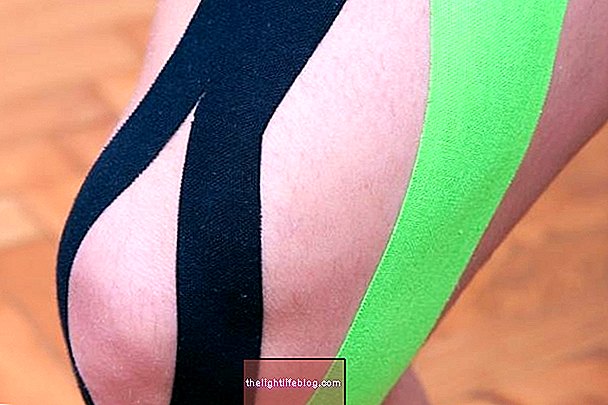The kinesio tape is a water-resistant adhesive tape that is used to speed recovery from injury, relieve muscle pain or to stabilize joints and preserve muscles, tendons or ligaments, during training or competition, for example, and should be placed by the physiotherapist or trainer.
The kinesio tape is made of elastic material, allows blood flow and does not limit movement, and can be applied anywhere on the body. This tape promotes the discreet lifting of the skin, creating a small space between the muscle and the dermis, favoring the drainage of liquids that may be accumulated in the site and that may be favoring the symptoms of muscle injury, in addition to increasing local blood circulation and promote better muscle performance and decrease fatigue.

What is it for
Kinesio tapes are used mainly by athletes during competitions with the aim of stabilizing and preserving joints and muscles, preventing injuries. These tapes can also be used by people who are not athletes but who have some injury or pain that gets in the way of daily life, as long as indicated by the doctor or physical therapist. Thus, kinesio tapes have several benefits and applications, and can be used to:
- Improve performance in training;
- Improve local blood circulation;
- Decrease the impact on the joints, without limiting the movements;
- Provide better support of the affected joint;
- Decrease pain in the injured area;
- Increase proprioception, which is the perception of your own body;
- Decrease local swelling.
In addition, kinesio tape can also be used in pregnant women who suffer from low back pain, with good results.
Although they can be used for various purposes, the use of tapes should be part of a treatment that also includes muscle strengthening and stretching exercises, in addition to other techniques to prevent and combat injuries, and it is important that their use is guided by the physiotherapist.
How to use the kinesio tape
Although anyone can benefit from the use of this functional bandage, they must be placed by a physical therapist, doctor or physical trainer at the injury site in order to offer better support, avoid pain and decrease muscle fatigue. These adhesive tapes can be placed in the form of X, V, I, or in the form of a web, depending on the purpose of the treatment.
The tape is made with hypoallergenic material and must be changed at most every 4 days, not being necessary to remove it to bathe.
Was this information helpful?
Yes No
Your opinion is important! Write here how we can improve our text:
Any questions? Click here to be answered.
Email in which you want to receive a reply:
Check the confirmation email we sent you.
Your name:
Reason for visit:
--- Choose your reason --- DiseaseLive betterHelp another personGain knowledge
Are you a health professional?
NoMedicalPharmaceuticalsNurseNutritionistBiomedicalPhysiotherapistBeauticianOther
Bibliography
- AY, Saime et al. The effectiveness of Kinesio Taping on pain and disability in cervical myofascial pain syndromeEffectiveness of kinesio taping in pain and disability in cervical myofascial pain syndrome. Brazilian Journal of Rheumatology. Vol 57. 2nd ed; 93-99, 2017
- ARTIOLI, Dérrick P .; BERTOLINI, Gladson Ricardo. Kinesio taping: application and its results on pain: systematic review. Fisioter Pesq. 2014; 21: 94-99. Vol 21. 1 ed; 94-99, 2014
- José Roberto de Souza Júnior. Effects of Kinesio Taping on the muscular performance of women with chronic lower back pain. The World of Health, São Paulo. Vol 42. 3rd ed; 494-511, 2018
- KALINOWSKI, Pawel; KRAWULSKA, Anna. Kinesio Taping vs. Placebo in Reducing Pregnancy-Related Low Back Pain: A Cross-Over Study. Med Sci Monit. Vol 23. 6114-6120, 2017























